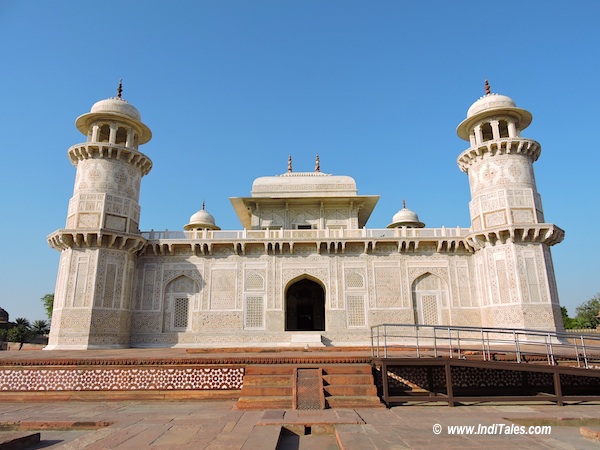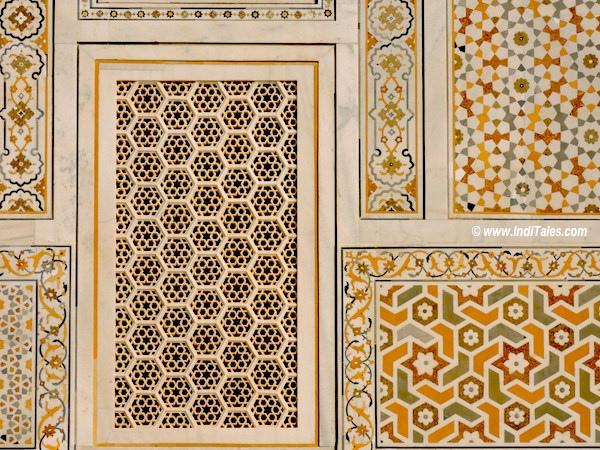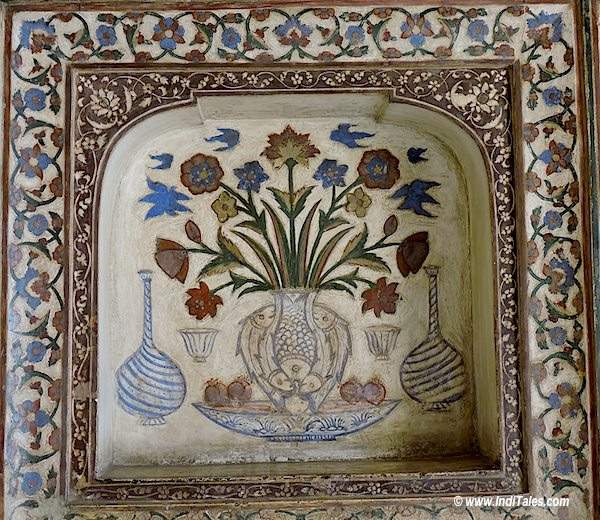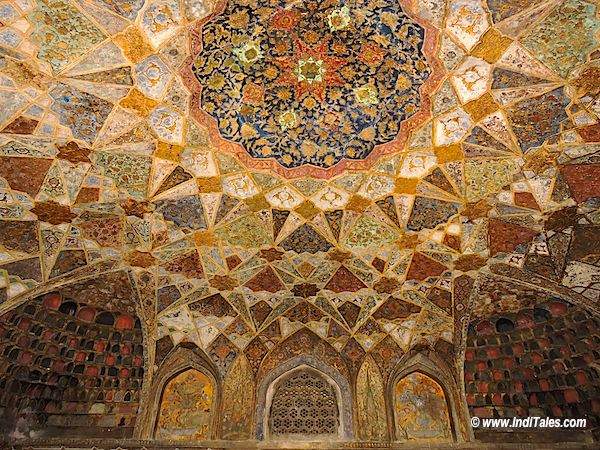I knew of Itmad-Ud-Daula also called Itmad-Ud-Daulah, but I had never been there. I knew Noorjehan built it for her parents as their final resting place – but that was all I knew. This time in Agra I got a chance to spend some time in this jewel-like building in white marble on the right bank of Yamuna. I heard stories of Noorjehan from our guides.
And now I recommend everyone going to Agra to must see this little wonder.
Story of Itmad-Ud-Daula

Itmad-Ud-Daula, the tongue twister title was given to Mirza Ghiyas Beg by Mughal emperor Jehangir, who was also his son-in-law. The story goes that Mirza Ghiyas Beg was a poor merchant in Persia. Who had no money to feed his newborn daughter? But this daughter was to change his fortunes and also make him immortal by building a beautiful tomb for him. Somehow the Mirza reached the Mughal court in Agra and was appointed a minister in the court of Jehangir. We would never know the correct sequence of events. But what finally happened is that Jehangir fell in love with the widowed daughter of Mirza and married her. She was none other than Noorjehan – claimed to be one the most beautiful and gifted women ever on the face of the earth.

In 1622, after Mirza Ghiyas passed away, daughter Noorjehan who was now the most powerful queen of India ordered this tomb to be built for her parents. Later her siblings were also buried in the same place.
Coincidentally Mirza Ghiyas Beg was also the grandfather of Mumtaz Mahal who is the woman buried in the Taj Mahal. It is said that Noorjehan wanted Shahjahan to marry her daughter from the first marriage. But Shahjahan fell for her brother’s daughter and the rest is history.
Architectural elements of Itmad-Ud-Daula

This tomb is supposed to be the first all-marble building in India, setting a trend for white marble structures. Historians also put it as the first draft for the Taj Mahal although there are many other buildings that stake the same claim. Till this point, most buildings in Agra and around were built with red sandstone. I must mention here that the tall gates around this monument are still made of red sandstone. And have inlay work similar to that of entrance gates at Taj Mahal and Akbar’s tomb. Even the platform on which the white tomb stands is made of red sandstone. Many other small structures within the complex are also in red sandstone that is found in abundance locally.

Persian & Indian Elements
There are both Persian and Indian elements in the architecture of this building. Arches and octagonal towers in the four corners of the tomb are Persian elements. The absence of a dome and the presence of closed kiosks and canopies on top are Indian influences. Though the building looks small, especially if you visit it after visiting the Taj Mahal or Agra Fort, or Akbar’s tomb, the gardens around it are quite spread out. You realize this when you see it from the other side of the road. In fact, they say if you take an aerial view, this tomb looks like a small jewel box kept in a garden.

Ornate Ceilings
Typically in a tomb, elements like flower vases and fruits, cypress trees, wine bottles, and fishes are not painted. But they can be seen on the walls of the monument. The ceilings on top of the tombs of Ghiyas Beg and his wife are most ornate and comparable to the painted ceilings of Akbar’s tomb at Sikandra. Ceilings are painted in rich colors with generous use of golden color.

Inlay Work
The outer walls are richly decorated with inlay work. Various stones like Carnelian, Jasper, Topaz, etc have been set in marble using the pietra dura technique. You primarily see a white structure with a lot of yellow and grey floral and geometric patterns on it. This is interspersed with the intricate jaali or latticework in white marble. Inside the tomb, most walls are painted.

Favorite Monument in Agra
When I asked my guide Aadil, which is his favorite monument in Agra – he said Itmad-Ud-Daula and this was before I saw it. I asked him why and he said – it has a delicate and feminine charm that no other building in Agra has. He went on to analyze that this is perhaps because a woman built it while all other buildings have been built by men. Or maybe it was a daughter’s love for her parents that brings a certain softness to the structure. When I reached here, I still had his words in the back of my mind.
The pietra dura or inlay work here does not have the finesse of the work at Taj Mahal, and neither are the bold colors used here. But the structure as a whole does have an element of Delicacy to it, a hint of vulnerability compared to the air of invincibility that most other structures carry.
Do plan a couple of hours for this delicacy in marble when you visit Agra next time.
Recommend you read the following travel blog posts on places to visit in Uttar Pradesh.
Fatehpur Sikri – City routed in the Saint’s blessing
Braj Bhoomi 84 Kos Yatra – Land of Radhe Radhe
City of Jhansi Ki Rani – Tourist Attractions















I love the Itmaduddaula Tomb. Thanks for this useful writeup.
It was a pleasant discovery for me too…
This is on my list ever since I read this book by Indu Sunderasan on Noorjehan….thanks for sharing this. It has been an interesting read
That reminds be Ami that I have to read that book. Have it with me in my library, but somehow never read it…
VERY NICELY WRITTEN…
Thanks Sourabh. Stay connected.
I HAVE BEEN THERE….WHAT ABOUT THE OTHER ONE NEAR THIS – WHICH IS IN REAL DERELICT CONDITION ?
Did not visit the other one, Agra deserves another visit.
It was great to know every detail about one of the popular historic place of our nation. Thanks for sharing such an amazing and informative post. The attractive and eye-striking architecture of the Itmad-ud-daula is really one of its kind. This well written article took me to historic times!
Glad that you liked the Itmad-ud-daula post on Inditales
Thanks for the memories. I visited there in late 70’s with my parents on visit to India. I still remember beautiful tomb with big garden, next to Jamna river.
Happy Rehan Ji, that this travel blog could ignite some old memories for you. It is always touching to know that my writing could touch an emotion in you.